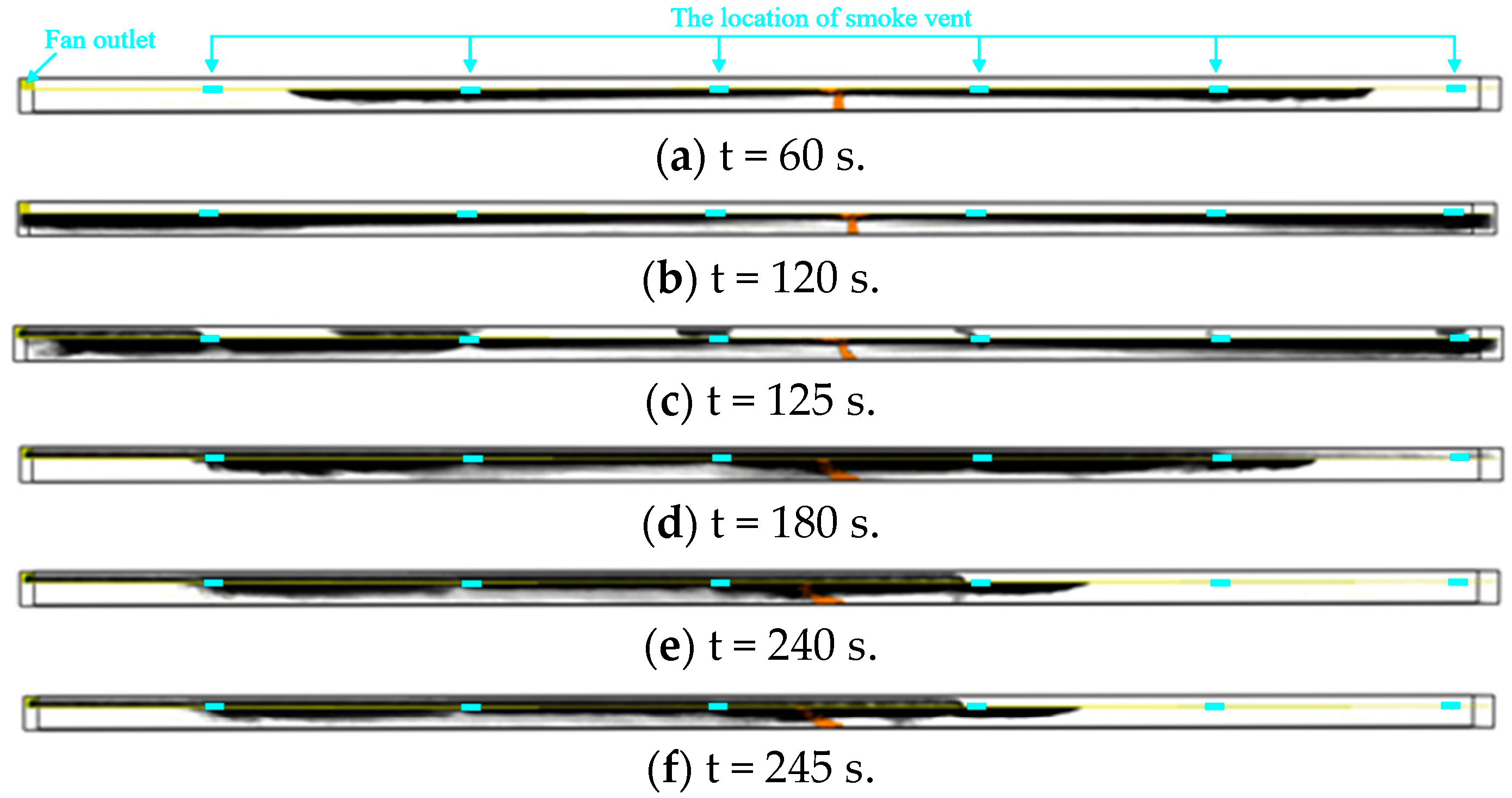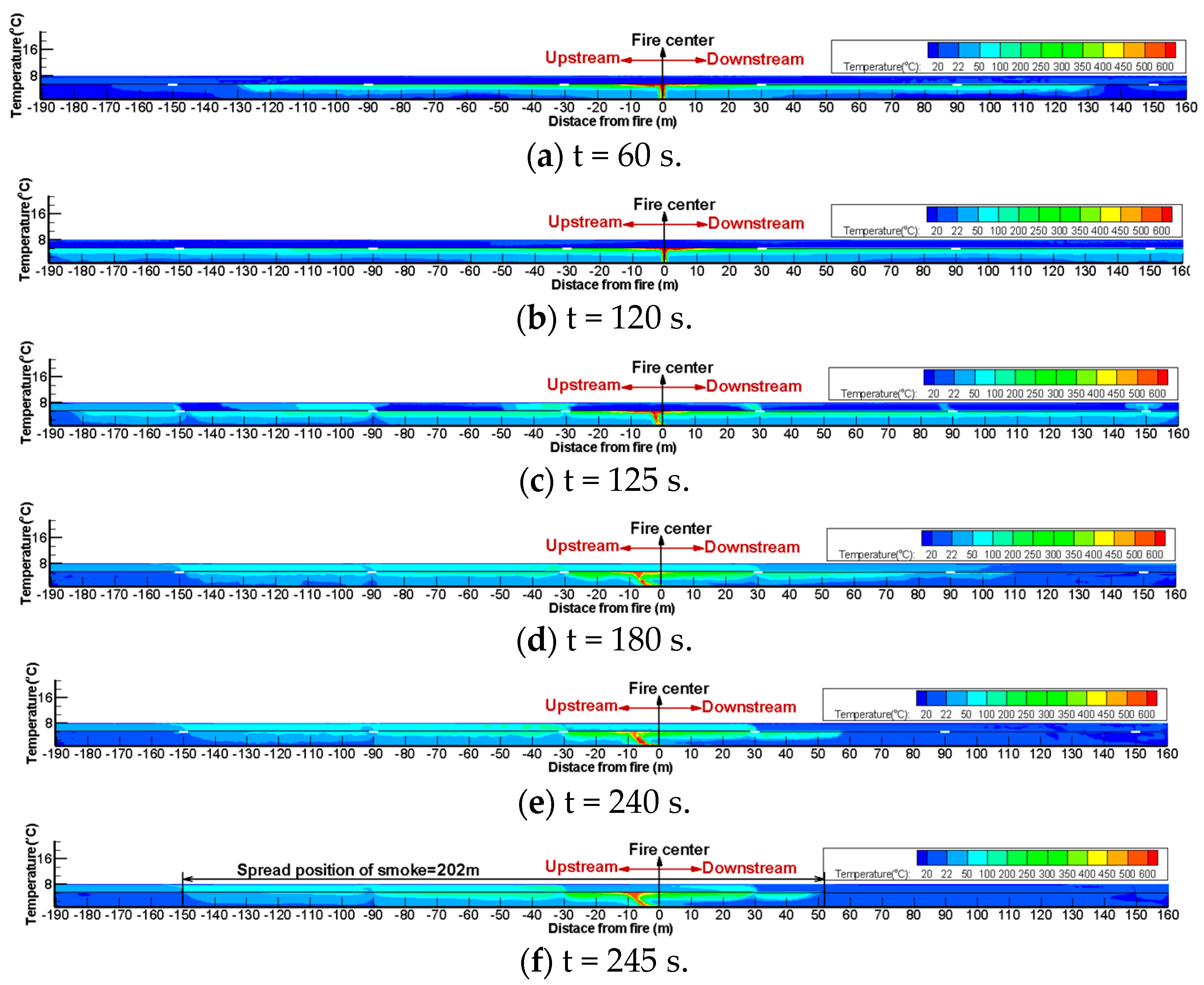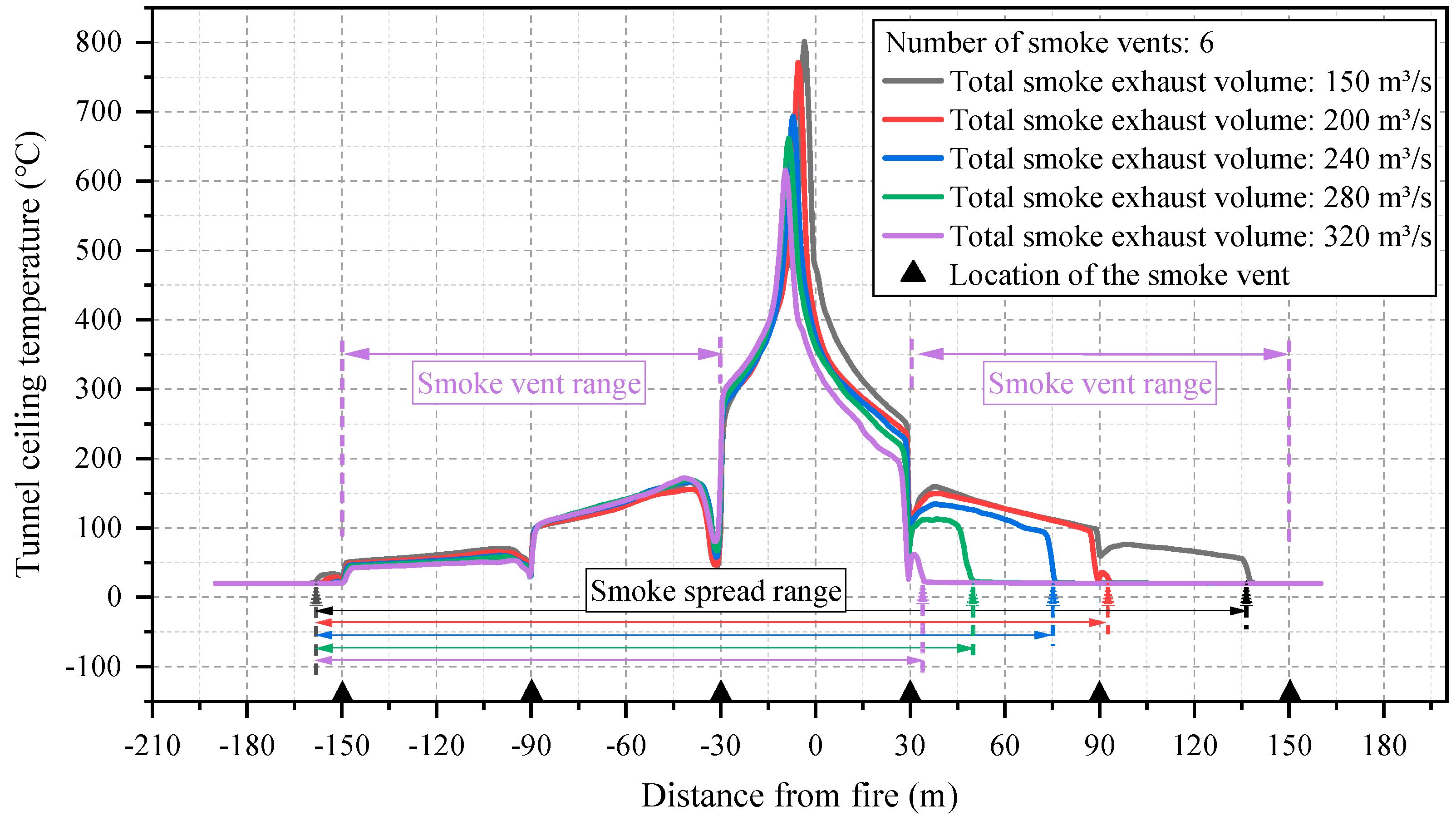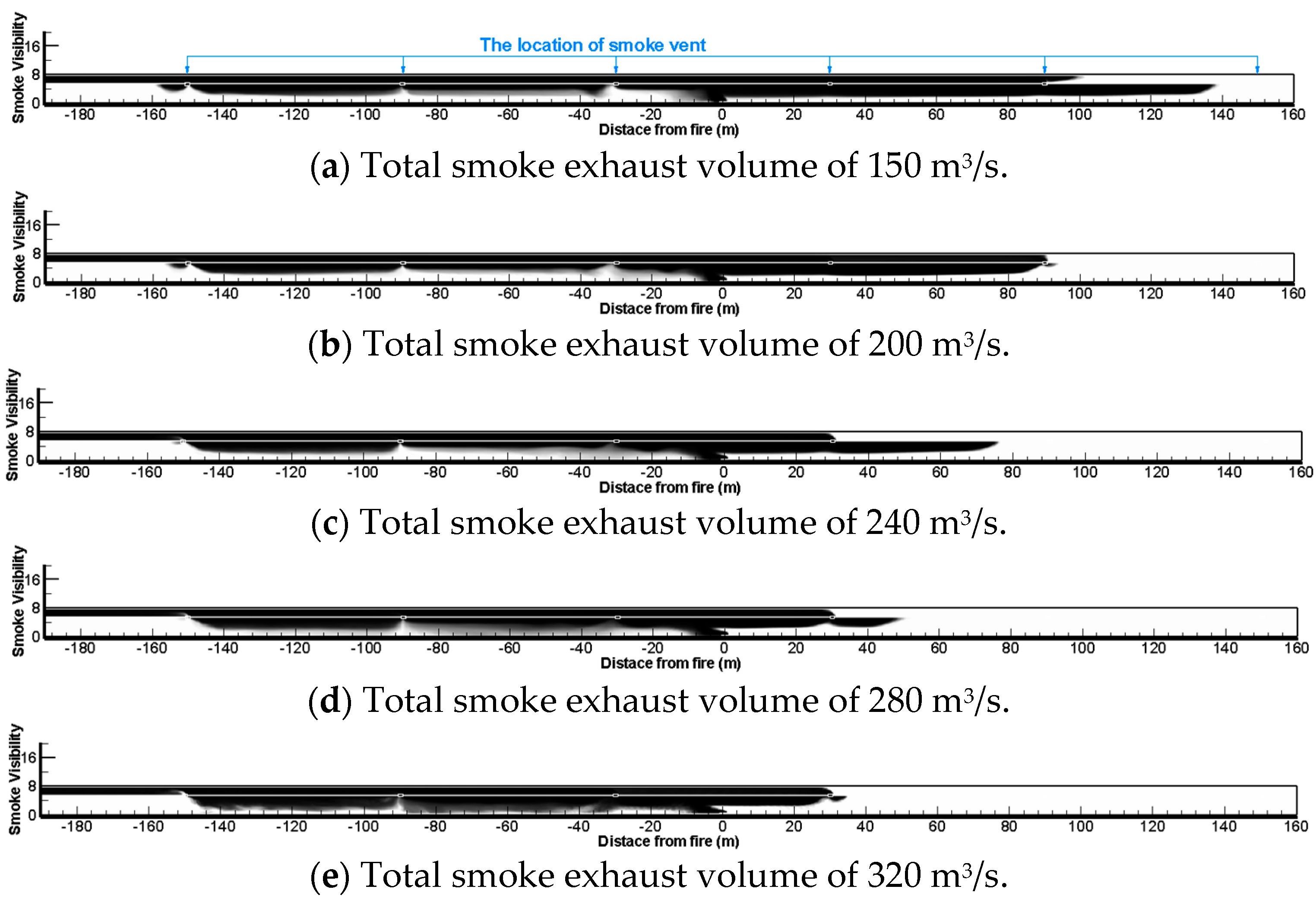Influence of Smoke Exhaust Volume and Smoke Vent Layout on the Ceiling Centralized Smoke Exhaust Effect in Tunnel Fires
Abstract
1. Introduction
2. Research Methodology
2.1. Fire Scenario
2.2. Grid Sensitivity Analysis
3. Results and Discussion
3.1. Smoke Spread and Temperature Profile over Time
3.2. Influence of Smoke Exhaust Volume
3.3. Influence of Smoke Vent Number
4. Conclusions
Author Contributions
Funding
Institutional Review Board Statement
Informed Consent Statement
Data Availability Statement
Conflicts of Interest
References
- Tao, L.; Zeng, Y.; Li, J.; Yang, G.; Fang, Y.; Li, B. Study on the maximum temperature and temperature decay in single-side centralized smoke exhaust tunnel fires. Int. J. Therm. Sci. 2022, 172, 107277. [Google Scholar] [CrossRef]
- Hu, L.; Liu, S.; Peng, W.; Huo, R. Experimental study on burning rates of square/rectangular gasoline and methanol pool fires under longitudinal air flow in a wind tunnel. J. Hazard. Mater. 2009, 169, 972–979. [Google Scholar] [CrossRef] [PubMed]
- Xu, S.; Cui, L.; Ning, L.; Wang, Z. Numerical Simulation and Analysis of Critical Velocity in Tunnel Fires Based on FDS. Adv. Mater. Res. 2014, 831, 455–459. [Google Scholar] [CrossRef]
- Li, J.; Zeng, Y.; Tao, L.; Liu, Z.; Li, B. Experimental study on temperature decay and smoke control in tunnel fires with combination of multi-point smoke exhaust and longitudinal ventilation. Int. J. Therm. Sci. 2023, 183, 107847. [Google Scholar] [CrossRef]
- Jin, J.; Jiang, X. A study of the characteristics of smoke stratification in lateral point smoke exhaust tunnel. Fire Saf. J. 2023, 140, 103833. [Google Scholar] [CrossRef]
- Wang, Q.; Guo, F.; Yao, Y.; Zhang, X. Numerical study on plug-holing of double fires in tunnel with centralized smoke exhaust. Tunn. Undergr. Space Tech. 2023, 142, 105419. [Google Scholar] [CrossRef]
- GB 50016-2014; Code for Fire Protection Design of Buildings. AQSIQ: Beijing, China, 2018.
- JTG/T D70/2-02-2014; Guidelines for Design of Ventilation of Highway Tunnels. Ministry of Communications of the People’s Republic of China: Beijing, China, 2014.
- Talmon, A.M.; Bezuijen, A. Calculation of longitudinal bending moment and shear force for Shanghai Yangtze River Tunnel: Application of lessons from Dutch research. Tunn. Undergr. Space Tech. 2013, 35, 161–171. [Google Scholar] [CrossRef]
- Xu, C.; Chen, Q.; Luo, W.; Liang, L. Evaluation of permanent settlement in Hangzhou Qingchun Road crossing-river tunnel under traffic loading. Int. J. Geomech. 2019, 19, 06018037. [Google Scholar] [CrossRef]
- Spratt, D.; Heselden, A.J. Efficient extraction of smoke from a thin layer under a ceiling. Fire Saf. Sci. 1974, 1001, 19741001. [Google Scholar]
- Vauquelin, O.; Megret, O. Smoke extraction experiments in case of fire in a tunnel. Fire Saf. J. 2002, 37, 525–533. [Google Scholar] [CrossRef]
- Jiang, X.; Zhang, Y.; Xu, Z.; Wei, D. Effect of different exhaust rates on fire smoke control in a shield tunnel. Sci. Technol. Rev. 2012, 30, 40–44. [Google Scholar]
- Yuan, J.; Fang, Z.; Tang, Z.; Li, Q.; Wang, J. Influence of smoke damper configuration on point extraction ventilation system of an urban tunnel. Procedia Eng. 2016, 135, 99–106. [Google Scholar] [CrossRef]
- Zhu, H.; Shen, Y.; Yan, Z.; Guo, Q.; Guo, Q. A numerical study on the feasibility and efficiency of point smoke extraction strategies in large cross-section shield tunnel fires using CFD modeling. J. Loss Prev. Process Ind. 2016, 44, 158–170. [Google Scholar] [CrossRef]
- Xu, Q.; Yi, L.; Xu, Z.; Wu, D. Preliminary study on exhaust efficiency of smoke management system in tunnel fires. Procedia Eng. 2013, 52, 514–519. [Google Scholar] [CrossRef][Green Version]
- Yi, L.; Wei, R.; Peng, J.; Ni, T.; Xu, Z.; Wu, D. Experimental study on heat exhaust coefficient of transversal smoke extraction system in tunnel under fire. Tunn. Undergr. Space Tech. 2015, 49, 268–278. [Google Scholar] [CrossRef]
- Liu, Y.; Yang, D. Experimental study on synergistic effect of exhaust vent layout and exhaust rate on performance of ceiling central smoke extraction in road tunnel fires. Int. J. Therm. Sci. 2023, 183, 107886. [Google Scholar] [CrossRef]
- Mcgrattan, K.; Hostikka, S.; Mcdermott, R.; Floyd, J.; Vanella, M. Fire Dynamics Simulator, User’s Guide (Version 6); National Institute of Standards and Technology: Gaithersburg, MD, USA, 2022. [Google Scholar]
- Lee, Y.; Tseng, L.; Su, C.; Li, Z.; Wen, C.; Yang, A. Effects of control zone, exhaust rate and station extent on smoke dispersal during emergency concourse fires in underground stations. Int. J. Therm. Sci. 2023, 191, 108363. [Google Scholar] [CrossRef]
- Ciambelli, P.; Meo, M.G.; Russo, P.; Vaccaro, S. Thermal radiation modelling in tunnel fires. Adv. Appl. Math. Mech. 2011, 3, 327–353. [Google Scholar] [CrossRef]
- McGrattan, K.; McDermott, R.; Vanella, M.; Hostikka, S.; Floyd, J. Fire Dynamics Simulator User’s Guide, 6th ed.; NIST Special Publication: Gaithersburg, MD, USA, 2022. [Google Scholar]
- Zhang, Q. Scene design and simulation analysis of fire accident in underwater tunnel. Procedia Eng. 2016, 166, 337–346. [Google Scholar] [CrossRef]
- Sturm, P.; Beyer, M.; Rafiei, M. On the problem of ventilation control in case of a tunnel fire event. Case Stud. Fire Saf. 2017, 7, 36–43. [Google Scholar] [CrossRef]
- Yan, Z.; Wang, Y.; Chao, L.; Guo, J. Study on Evacuation Strategy of Commercial High-Rise Building under Fire Based on FDS and Pathfinder. Comput. Model. Eng. Sci. 2024, 138, 1076–1102. [Google Scholar] [CrossRef]
- Ye, K.; Zhou, X.; Yang, L.; Tang, X.; Zheng, Y.; Cao, B.; Peng, Y.; Liu, H.; Ni, Y. A multi-scale analysis of the fire problems in an urban utility tunnel. Energies 2019, 12, 1976. [Google Scholar] [CrossRef]
- Hu, L.H.; Huo, R.; Li, Y.Z.; Wang, H.B.; Chow, W.K. Full-scale burning tests on studying smoke temperature and velocity along a corridor. Tunn. Undergr. Space Tech. 2005, 20, 223–229. [Google Scholar] [CrossRef]










Disclaimer/Publisher’s Note: The statements, opinions and data contained in all publications are solely those of the individual author(s) and contributor(s) and not of MDPI and/or the editor(s). MDPI and/or the editor(s) disclaim responsibility for any injury to people or property resulting from any ideas, methods, instructions or products referred to in the content. |
© 2024 by the authors. Licensee MDPI, Basel, Switzerland. This article is an open access article distributed under the terms and conditions of the Creative Commons Attribution (CC BY) license (https://creativecommons.org/licenses/by/4.0/).
Share and Cite
Shi, Y.; Qian, S.; Zhao, P.; Guo, P.; Gao, Z. Influence of Smoke Exhaust Volume and Smoke Vent Layout on the Ceiling Centralized Smoke Exhaust Effect in Tunnel Fires. Fire 2024, 7, 78. https://doi.org/10.3390/fire7030078
Shi Y, Qian S, Zhao P, Guo P, Gao Z. Influence of Smoke Exhaust Volume and Smoke Vent Layout on the Ceiling Centralized Smoke Exhaust Effect in Tunnel Fires. Fire. 2024; 7(3):78. https://doi.org/10.3390/fire7030078
Chicago/Turabian StyleShi, Youzhi, Shixiong Qian, Pengju Zhao, Pan Guo, and Zihe Gao. 2024. "Influence of Smoke Exhaust Volume and Smoke Vent Layout on the Ceiling Centralized Smoke Exhaust Effect in Tunnel Fires" Fire 7, no. 3: 78. https://doi.org/10.3390/fire7030078
APA StyleShi, Y., Qian, S., Zhao, P., Guo, P., & Gao, Z. (2024). Influence of Smoke Exhaust Volume and Smoke Vent Layout on the Ceiling Centralized Smoke Exhaust Effect in Tunnel Fires. Fire, 7(3), 78. https://doi.org/10.3390/fire7030078





